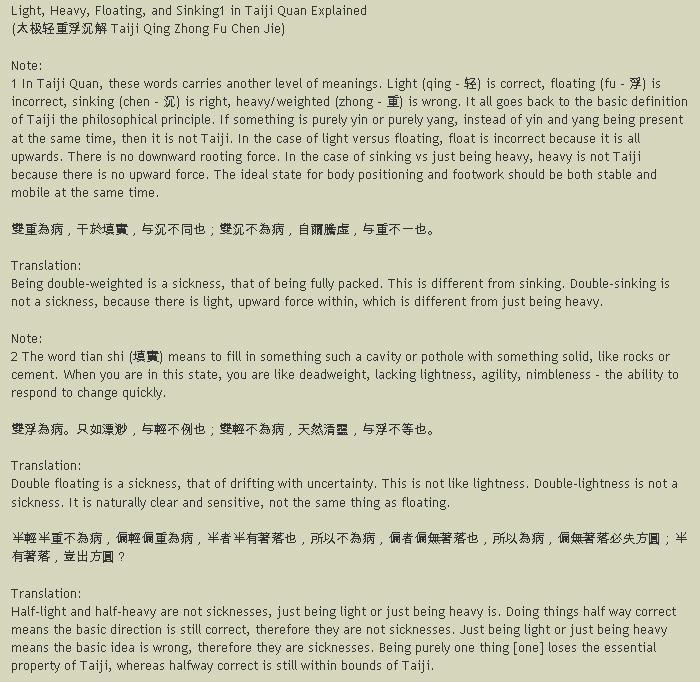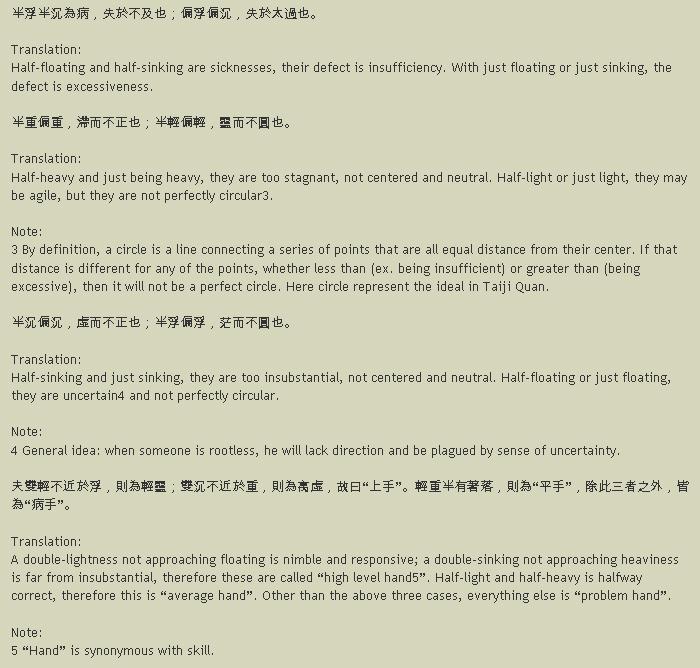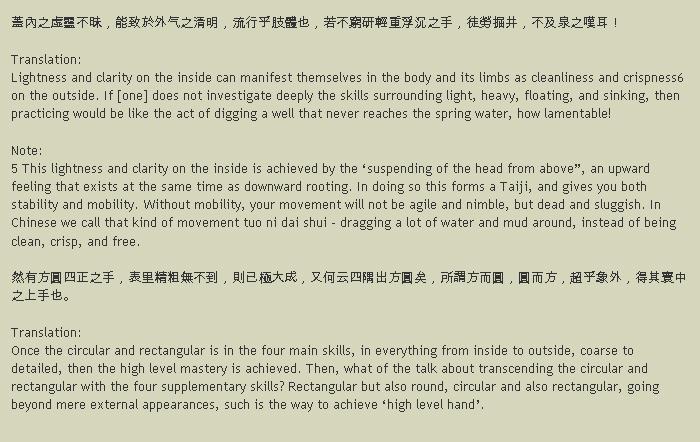On Different Types of Martial Force (Power) - Yin Style Baguazhang
Written by Doctor Xie Peiqi, (Translation by Eric C.)
功夫中的明勁又叫作:外剛勁、整勁、絕妙勁、脆勁、抖勁,也有稱為顫勁。明勁在發放運動上,又有尺寸之分。尺勁和寸勁的區別是尺勁的發放距離較長,俗話說一寸長一寸強,要有發放的位置。寸勁發放的距離較短,俗話說一寸小一寸巧。尺勁的發放距離如是一尺的話,那麼寸勁的發放距離,即在三寸至五寸之間。所以在內家拳中,就是要追求和練尺寸勁。因為在運動中尺勁和寸不僅在勁上有著差別,而且在運動的速度上更有差別。下面我們就談談這方面的道理及功夫。
The obvious force of martial development is also known as "external hard force", "whole (body) force", "exquisite force", "crisp force", "shaking force", "trembling force" or "shuddering force."
When emitting obvious force during exercise, there are also differences in the length of the force. The difference between foot-length force and inch force is that the distance across which the first is emitted is comparatively long. It is said that for every inch of length you have an inch of strength and this force must have a place of emission. The distance for inch force is comparably short. It's said that for each inch shorter, one is an inch trickier. If a foot force should be emitted within a foot of the opponent, an inch force should be emitted within a fist or fist-and-a-half of distance. In the internal arts, it is the foot and inch forces that are sought after and trained. In the execution of their movements, foot and inch forces do not merely vary in regards to their force; the contrast between their respective speeds is even more apparent.
Below we will discuss the theory and development of such forces.
明勁中的尺勁,由於它從發放氣力勁開始至運動的技擊終點為止,整個運動過程的距離較長,所以花費的時間也較長,沿途減力,因此對方很容易及早地發現技擊意圖,有了採取破解措施的準備時間,尺勁在發放過程中,由沿途路長至終點,內含的氣力勁減失一半,所以在動手比手過程中,要應付突然變化,就顯得僵滯呆板招慢,而且尺勁在通過距離的運變,必然要消耗掉一部分力勁。所以它在到達終點時,要比發出來的氣力勁減少一半左右。
As for the foot force of obvious force, from its emission point of circulation, strength and force to is conclusion on impact, the entire process of the movement is quite long; the length of time it requires is also quite long. Along the path of its movement, strength is diminished; because of this, the opponent has a better chance of discovering the intent of one's attack early on and has time to respond with a counter to break the technique. In the midst of its emission, foot force follows a long path until it reaches its terminus and loses about half of its supporting circulation, strength and force in the process.
When fighting or comparing skills, one needs to cope with sudden changes, which makes stiff & non-agile techniques appear slow. Furthermore, foot force must lose about half of its force over the course of its movement as half of its circulation and strength is diminished between the moment of its emission and its terminus.
而內功較深的人,爆發力較強的內家拳拳師,對於氣力勁的運用,則是舍遠而求近,棄尺而得寸的,其目的就是在最短距離中,爆發出最大的沖貫拌氣勁來。我們知道,發放氣力勁距離愈短,到達打擊目標的速度也就愈快,對方的防禦和變化的難度也就愈大,所以內經拳要追求寸勁,也正是因為這個道理。但是要在最短的距離間,發出最大的氣力勁來,卻不是一件容易做到的事情,需要經過長久的鍛煉能夠得來。所以初學的明勁功夫,得到的只是明尺勁,而不是寸勁,尺勁階段,還屬於僵滯之剛勁,而不屬於柔中之剛勁,等練到柔如繩之系,漢如冰之清的寸勁時,方為柔中之剛。
不給對方添勁,發力冷脆快,化力柔小綿軟,但無論是尺勁還是寸勁,都需要逐步掌握和運用好,神、意、氣、力、勁的同一時發放,使氣體、液體、固體三者在一瞬間能夠配合無隙,發揮出整體最大的功夫來。
As for those with comparably deep development and comparably strong explosive force, with their emission of circulation, strength and force, they abandon the far and seek the near, they abandon the foot and seek the inch. Their objective is to violently emit, in the shortest moment, the greatest rushing, connecting & mixing of circulation & force. As we know, the shorter the emission of circulation, strength and force, the faster the arrival of the strike upon its target and the greater the difficulty for an opponent attempting to counter or change. In accords with this reasoning, practitioners of the internal arts require inch force.
Nevertheless, emitting the greatest amount of circulation, strength and force in the shortest amount of time is not a condition that is easily achieved; its development requires long and arduous training. Therefore, new practitioners trying to attain obvious force are only able to attain foot force, not inch force. The stage of foot force belongs to a hard force that is stiff & sluggish, not the hard force that is issued in suppleness; one wishes to train until one can emit an inch force as supple as a rope twisting into knots yet as firm as pure ice. This then is the hard within the pliant/soft.
One should not add to the opponent's force. One should emit a force that is sudden/cold, crisp and fast; one should remove force through suppleness, small (adjustments) and softness. Nevertheless, whether one is using a foot force or an inch force, both require gradual mastery & consecutive use of one's spirit, intent, breath/circulation, strength and force all at the moment of emission. The breath, blood & solids in one's body must combine in an instant of unbroken coordination; this brings the largest amount of development throughout the whole body into play.
從另外一個角度來講,明勁的初練過程,也是易骨的過程,是為力"壯基築體",增強全身各部位關節和骨骼的支撐力量,以及增大各關節的活動範圍,特別是四肢稍節,無論是採用手打或足打,都需要有較大的對抗力量,否則就會在技擊運動中,因撞擊對方而造成自己損傷,所以明勁既是初步的鍛鍊方法(指尺勁),也是最終在實踐中運用的勁節(指寸勁)。
Considering it from another angle, in the first stage of developing obvious force, one is in the process of changing one's bones, using strength to "fortify the foundations and build up the body", while increasing the supportive strength of all the different joints and bones throughout the body as well as increasing the range of motion in all the joints, especially in the extremity joints of the four limbs. Regardless of whether one is striking with one's hands or feet, both require a comparably large amount of resistant strength; otherwise, when one strikes the opponent, one will injure oneself on impact. Hence, obvious force is the first of the methods to be trained (this is referring to foot force) and is later a force used in combat (this is referring to inch force).
明勁在運用上主於進攻,暗勁在運用上主於剋制,化勁在運用中主於順化及領化。明勁、暗勁、化勁三種經不同的修練法主要區別是:明勁在於手,暗勁在於肘,化勁在於腰身。雖然在打法中,不盡然是只限於手,尚有肘打、肩打、膝打、胯打、背打、腕打、拳打、足打、腿打、腰打腰御。但在明勁的初級功夫中,必須首先將氣力勁通達於末稍關節。
In usage, the purpose of obvious force is to attack, hidden force to control, transforming force to transform smoothly with the opponent's force or to lead it with transformation. The primary difference in the methods of practice between obvious, hidden and transforming forces is this: obvious force is primarily expressed by the hands, hidden force by the elbows and transforming force by the waist & body. Although obvious force is about striking, its potential is not limited to the hands; there are also elbow strikes, shoulder strikes, knee strikes, hip strikes, back strikes, wrist, fist, foot & leg strikes as well as striking and removing with the waist. Still, in the initial development of obvious force, one must first succeed in sending one's strength and circulation to the joints of the extremities.
明勁(指寸勁中明勁)並不是孤立運用的,而是要同暗及化勁相互配合使用的,或用暗先剋制住對方的發力,而後緊接著轉換招法,以明勁進攻對方。或用化勁破解對方(又稱"以巧破千斤")然後急轉變剛勁,沖穿貫抖攻擊對方,所以此時明勁的運用,並不是貫穿進攻動作的始終,而只是用於達到目標前的一刹那間,因此稱之為寸勁。過去內家拳老前輩常用"石中火、閃電光、震雷嗚",來形容氣力勁的使用發放和運動,實際上這裡包含著速度、角度、尺寸、距離、時間和力量,說得具體一些,就是爆發勁的速度愈快,沖擊力也就愈大;進攻對方的距離愈近,愈容易給對方增大防禦和破解的困難;時間愈短,進攻愈容易見效。關於角度問題,身體的轉動,手的起落,小臂的擰轉必須是構成九十度(即四十五度加四十五度),或者擰轉四十五度。時間問題,是一個氣力勁爆發的火候問題,既不能爆發得過早,也不能過晚。過早則會使爆發之氣力勁未觸其身,且難收其效果;過晚又會形成尺過己過。所以說過早或過晚都會影響爆發氣力勁的作用。一定細心體會和掌握"近在眼前一寸中"這個火候,才能爆發出來石中求火打閃紐針。穩準狠冷脆快的急中有剛,剛中有柔,而且是始之有謀終之有效。
Obvious force (of the inch variety) is not used on its own, but in combination with hidden & transforming forces. For example, one uses hidden force to control the opponent's ability to put out force/strength, then immediately following this one switches methods, using obvious force to attack the opponent; or perhaps one will use transforming force to break the opponent's technique (also referred to as "using skill to break 1000 pounds"), then rapidly switching to hard force, rushing, penetrating, threading through or shake attacking the opponent. Now using obvious force in these instances does not mean the obvious force is at the beginning or end of movements passing through, penetrating or entering in to attack; rather, obvious force is issued at the very instant before one has reached one's striking target and hence, it is referred to as "inch force".
In the past, older generations of practitioners would use the following lines to describe the emission and movement of circulation, strength & force: "the magma within the rock, the brilliance of the lightning, the cry of thunder". In actuality, these sayings contain the notions of speed, angles, lengths, distance, timing and strength. To put it more concretely, the faster the emission of explosive force, the greater the rushing & striking strength; the closer to the opponent when unleashing one's attack, the greater the difficulty the opponent will find in warding off or breaking the attack; the shorter the duration of the attacking movement, the easier it'll be to realize its effect.
Regarding the question of angles, the turning of the body, the rise & fall of the hands and the rotation of the arms, all must form 45 degree angles or 90 degree angles (namely, one 45 degree angle joining another 45 degree angle).
As for timing, it is an issue of emitting circulation, strength & force at the critical moment; one cannot be too early or too late in one's emission of force. If one emits too early, the explosive effect of the circulation, strength & force will not fully connect with the opponent's body; if one attempts emission too late, the appropriate time will already be far past. Therefore, emitting too early or too late will adversely affect the result/function of the explosive emission. One must attentively experience & master the crucial moment of emission as if it were "as near as an inch in front of one's eyes". Only then can one emit explosively as if "seeking magma within the rock" or "stitching a needle by lightning flash".
Within the urgent violence of stable, accurate, vicious, sudden/cold, crisp & fast there is also hard; within hard there is pliant/soft.
Every technique must initiate with a plan and end with a result.
明勁是練合求剛,暗勁是練沽求柔順,化勁是練靈活求巧妙,合,是上下外內氣、液、固三體相合為一,要體現出一個"整"字來。剛,是要爆發出快中有剛硬(急中之剛謂之真剛)。剛中之急(謂之真急),才為"漢如冰之清"的急剛硬勁。活是圓活不滯,變化莫測。柔,是勁似抽絲,連綿不斷,外柔內剛或內柔外剛,剛柔相濟,不僵不拙,沾纏綿隨。靈,是轉動迅速,變化靈敏巧妙,進腿自如,吞吐隨身意。巧,是不丟不頂,不即不離,一羽不能加,蟲螥不能落,不動則已,動而成圓,因此內家拳中講,有"以一巧破千斤"之說。
Obvious force trains harmony to seek hardness; hidden force trains the gaining & relinquishing of purchase to seek pliancy & smoothly flowing with; transforming force trains agility to seek a clever & subtle skill.
"Harmony" means the breath, blood & solids in the upper & lower body as well as the inside & outside of one's body must all harmonize in unity; one must embody the concept of "a whole in proper order".
"Hardness" means that in the midst of the speed coming from an explosive emission, there must be firmness (the hardness that can be drawn upon in urgency is referred to as "true hardness"). The urgent violence found within hardness (also referred to as "true urgency") is the hard urgent force of the saying "firm as if pure ice".
"Lively" means to be round & lively without obstruction and to possess unfathomable changes.
"Pliancy/softness" means one's force is as if reeled silk, continuous & unbroken, soft on the outside & hard within or soft on the inside & hard without; hard & soft mutually assisting one another, neither stiff nor clumsy, sticking, binding, soft & following.
"Agility" means to turn and move at a rapid speed, with changes agile & nimble, skill clever & subtle, advancing one's legs in with a smooth ease, bringing one's strength inward & spitting it outward in accords with the intent of the body.
"Clever skill" means neither losing contact with the opponent nor resisting force-on-force; neither allowing them to be too close nor too far, such that not even a feather's weight can be added (without reaching excess), such that the contacting force would be insufficient to knock the shell of an insect to the ground; when the opponent's movement stops, so does one's own; when both are moving, one draws circular movements. Hence, with the internal arts it is said: "one uses skill to break one thousand pounds".
暗勁,顧名思議,是一種暗藏的勁,也是柔中含剛的韌勁。暗勁在內家拳中,主要是暗藏在丹田、腰、肩、肘之中。肩肘是上肢的根中枝節,根節中節為藏勁之所,變化之本,"中節空則節節空"(此話雖然指腰,然上肢不例外),所以練內家拳必注重鬆肩沈肘,沈中之靈為真靈,浮中之靈為飄靈,是不堪一擊的。因而在練習第一步暗勁功夫時,必須把勁真正集於肩肘之中。
"Hidden force", as its name implies, is a type of concealed force; it is also a tenacious force that is hard within its pliability.
Within the internal arts, "hidden force" is primarily concealed in the lower abdomen, the waist, the shoulders & the elbows. The shoulders & elbows are the joints that connect the rest of the arm with the root of the arm; these rooting joints are places where force is concealed and are the basis of change. It is said that "if the middle joint is empty, then all joints are empty"; while this was said referring to the waist, the upper limbs are no exception. Hence, practitioners of the internal arts must pay attention to relaxing the shoulders and dropping the elbows. The efficacy of a sunken middle joint is true efficacy, whereas the efficacy of a floating middle joint is itself floaty and unable to withstand a single blow. Therefore, the first step of training the development of a contained force requires one to genuinely accumulate force within the elbows & shoulders.
暗勁的鍛煉過程,是一個長內含重力,續發力(即二力)伸展之力的過程,暗勁在內家拳的運用中,主要是為了剋制對方和感覺對方的一動一靜,所以暗勁是在持法中常常使用的氣力勁。敵方之氣力勁發不出來,變化不動,腿不了,進不了。
Training hidden force is a process that develops heavy strength, continued strength (also known as "secondary strength") as well as a stretching/extending strength. In the usage of the internal martial arts, hidden force is primarily used to control the opponent and listen to the changes in his movement; hence, its circulation, strength & force are generally called upon in the methods of control. When the opponent cannot make use of his circulation, strength or force, he'll be unable to change his technique, unable to retreat, unable to advance.
化勁,是一種順從對方用來的氣力勁,往來的領化勁,它主要是鍛煉內勁的聽力,內氣力勁的轉變靈巧,在運用上它有不丟不頂,舍己從人,彼柔我剛,彼剛我柔,彼動我靜,彼來我先動。彼不知變化之巧妙為我用之,這在內家拳中也是易髓的過程。
Transforming force is a type of force that complies with the circulation, strength & force of the opponent so that one may lead him hither or thither. It is primarily the practice of listening to the opponent's strength with one's own internal force as well as the agility & changes of that internal circulation, strength & force [translator's understanding: "internal force" is force issued outward from the core of the body, a.k.a.: the "waist" in Chinese]. In usage, transforming force must not lose contact with the opponent nor meet force-on-force. One momentarily abandons one's own course and follows that of the opponent; if he is pliant, I am firm; if he is firm, I am pliant; if he enters into motion, I am still; when he initiates his attack, I strike first. While my opponent fails to understand the clever & subtle skills involved in changes, I am able to make use of them.
化勁在練功時,無論是進退起落,伸縮開闔,吞吐翻轉,其走步換勢都要取萬物之靈通之象形,輕靈敏捷,周身動轉要如同水之翻浪,連綿不斷,無疆無滯,無而不入,要體現出運動如流水,源源不竭,動轉曲曲順流,似球滾動,圓活無滯無疆拙的現象。
When training the development of transforming force, whether advancing, retreating, rising or falling, extending, contracting, opening or closing, taking in, sending out, turning over or around, the stepping & technique changes should be as fluent & mysterious as the processes of nature herself. Light, quick and agile, the entire body should move & turn as if swept by water, capsizing with its waves, continuous & unbroken, without stiffness nor obstruction, gaining entry from every point. The movements of the body should be as if flowing water, an endless & inexhaustible stream, winding & flowing with the current. As if a rolling sphere, the body's appearance should be round & lively without obstruction nor stiff clumsiness.
.






